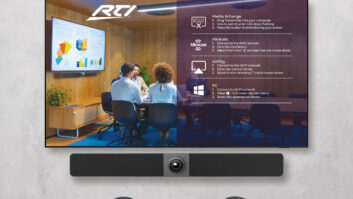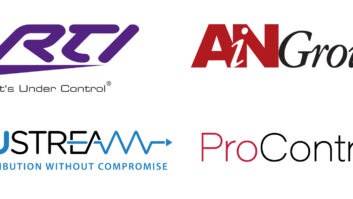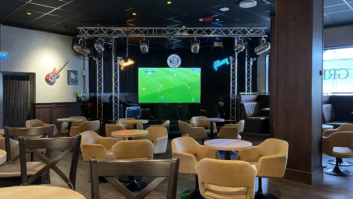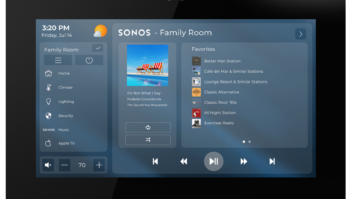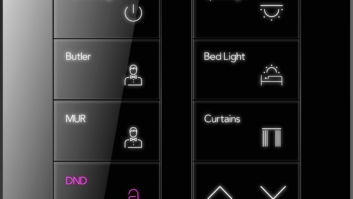My visit to Minnesota last week, along with my colleague Kirsten Nelson, editor of Systems Contractor News, provided a thorough update of Remote Technologies Incorporated’s latest product developments and an inside look at that company’s relatively new corporate headquarters in Shakopee.

For a slideshow of my visit, please click here.
Having been to RTI’s previous HQ back in the winter of 2006, I was impressed by the evolution of their offices right away. While it’s still a relatively spartan setup (lots of empty shelves and room to grow), I loved the modular meeting spaces and modern décor of the new digs. It was an inviting work space with lots of areas for stress relief and brainstorming sessions.
Similar to the previous RTI HQ there’s a modest game room with popcorn machine, shuffleboard table, and pinball machines. Vice president of marketing Pete Baker told us that he’ll sometimes find an engineer playing pinball, and can see in his eyes that his mind is working out a technical challenge while he plays.
The pinnacle (pun intended) of stress relief in the RTI offices, however, is a full-scale driving range almost as big as a single bay at one of those executive ranges like Chelsea Piers in New York City. I took a few swings and felt refreshed after my flight from Indianapolis through Chicago O’Hare earlier that morning.
But recreation wasn’t the point of our visit. Lunch was! Just kidding. As we sat down to share sub sandwiches from Jimmy John’s, Baker and technical support manager/marketing assistant Brett Stokke told us about their much-anticipated two-way control products. Starting with RTI’s T2-C, T3-V, and T4 handheld controllers and the RK3 and K4 in-wall controllers, RTI’s two-way enabled devices begin shipping in May 2009.
The upshot is that by utilizing RTI control processors and wireless ZigBee technology, feedback from AV and environmental systems is now possible. The user interface is designed to be both easy to implement and customize by the installer using RTI’s Integration Designer software. Integration becomes even more convenient using bidirectional communication drivers developed by RTI via its Integration Partner Program for industry-leading partners and control of Escient media servers, Panasonic IP cameras, Lutron lighting controls, and Aprilaire HVAC systems, to name a few.
The secret to much of RTI’s success has always been the intuitiveness of their programming software. “With very little or no training someone can walk and do some very basic programming with our products. To get to really advanced sophisticated programming training is still required, though. “Our software caters to both ends of the spectrum–an entry-level person won’t be overwhelmed and a top-level programmer won’t get bored with it either,” Baker said.
He added, “I’ve always felt that the most important thing for us was to provide education to our dealers for our programming software, because once they they are educated on the software, I really think they’ll fall in love with the RTI product line. The programming software complements the products really really well.”
The company’s Advanced Control University has been expanded considerably (online interactive training which is hosted now for the first time by RTI staff several times a month instead of via AVAD University which had limited RTI’s exposure to international partners in the past). The company will also expand its downloadable video training in coming months. The plan is to create upwards of 50 video segments, which will enable a dealer to drill down to specific product details.
RTI also plans on hosting training classes at its headquarters for international visitors after trade shows and target sessions for a product advisory board for market research.
Due to tough market conditions right now Baker said RTI found it was necessary to revisit its distribution game plan, taking a really hard look at its path to the market. That led to an ongoing plan to expand RTI’s representation in the U.S. and gain access to other dealers beyond the AVAD network. Volutone was the first distributor added for the western U.S., and C.E.D. announced its appointment as an Illinois and Wisconsin distributor for RTI shortly after our visit. RTI is also looking to increase its middle-market business on the commercial side as well.
Baker noted that his company places a high value in the reliability of the automation and control system and as such they want to make sure that when a button is pushed that there’s solid automation that happens. “That’s why we store the macros and commands in the processor,” he said. “Now with two-way control we store the drivers in the processor as well.”
Baker and his team are working out the final kinks before the product ships, but he said that it has worked great so far. “It really is a revolutionary way of implementing two-way,” he said. “Two-way is one of the most advanced programming techniques that programmers run into. It’s really been reserved for more sophisticated projects and more advanced programmers. We want to make that more available to the mainstream professional integrator.”

Baker said that it’s been a lot of hard work for RTI to develop the program so it’s very intuitive and efficient, yet it allows for more advanced programmers to “wander off the path” and eventually write their own drivers. “What makes it revolutionary is that if a programmer has no experience writing a two-way driver, you can still go in there and do some very advanced programming with the drivers that are supplied with the software. Eventually there will be a separate areas for writing their own drivers that can be implemented and used by less experienced programmers. You won’t have to go in there and edit the strings and edit the drivers.”
Initially, two-way will only be supported on RTI’s XP-8, which is the company’s high-end remote control processor with astronomical time clock, eight routable IR ports, and eight dedicated RS-232 ports. All color in-wall touchpanel products will be upgradeable via a firmware update as well.
Among the other introductions related to the two-way product line are the new ZM-24 Transceiver Module and a new graphical user interface for two-way-enabled controllers that includes visual feedback from supported devices, including current song selection, security status, and environmental services, such as HVAC or lighting. Web-based templates also provide the end user with quick access to current and forecasted weather conditions directly on their controllers.
Additional products include CPB-1 control port connecting block, the T1-B button-only handheld universal system controller, PCM-8 port control module, ZRP-5 and ZRP-6 ZigBee-compatible control processors, and the MRP-64 multiroom control processor.
It’s a lot of new and exciting stuff for a control systems manufacturer that caters well to a lot of the custom installation market and is beginning to reach into the commercial AV channel as well. After a quick run to Baker’s house for an in-home demo, I was headed back to the airpot with my head swimming with product specs and new technical knowledge. For a first-hand look yourself, check out RTI at InfoComm in Orlando next month. Otherwise, watch the company’s website (www.rticorp.com) for video demos or check them out at CEDIA EXPO in Atlanta this September.
